The Auschwitz-Birkenau concentration and execution camp represents some of the worst humanity has had to offer. It served as the largest concentration camp established by the Nazi regime and the most streamlined implement of genocide of World War 2 non-combatants.
1.1+ million people were murdered here between 1940 and 1945.
Planning a visit to Auschwitz-Birkenau Memorial and Museum:
Getting from Kraków to Auschwitz-Birkenau independently: Take a direct bus from Kraków’s main bus station (next to Kraków Główny railway station) for about a one hour trip. There are frequent departures daily, just show up at the station and ask for a ticket and which platform on which to wait. We didn’t buy our tickets in advance, and I doubt you’d need to either. Leaving early in the day is best (as it usually is for all things touristic).
Returning to Krakow: Transit back to Kraków is easy as well – buses pull up just outside the Auschwitz-Birkenau Museum bus parking lot (not on the street – still within the gated area). A timetable is posted at the stop. Beware of catching return buses to Kraków late in the day, they fill up fast and getting a seat can be a battle (or at least it was for us in August 2012).
Should I stay in Kraków, or find lodgings near Auschwitz-Birkenau? That depends – if your goal is to do a multi-day visit to the Auschwitz-Birkenau site, it might benefit you to stay close by. But if you’re on a day trip, sleep in Kraków. The towns surrounding the concentration camp aren’t particularly engaging in my opinion, and there’s much to do and see in Kraków.
Admission to the Auschwitz-Birkenau Memorial and Museum is technically free to independent individual visitors, but in the hour of our arrival, we were required to hire a guide due to April-through-October high-season regulations. The tour cost 40 PLN per person. In off-season, guides are not required (but take a guided tour anyway, it’s worth it).
Figuring out how to get our tickets was a bit confusing and annoying. The entrance and ticketing hall of the site is a bit of a free-for-all, ticketing lines aren’t as clearly marked as they need to be, and clerks were a bit surly. Be patient.
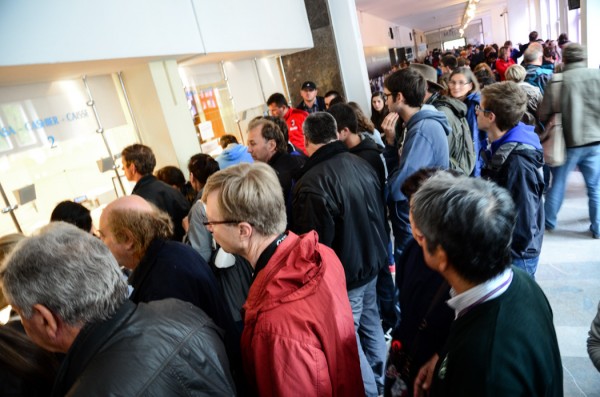
the entry hall was a bit chaotic.
Guided tours are offered in Polish, English, French, Italian, German and Spanish. The site visit takes about four hours, so eat beforehand and wear appropriate walking shoes. Audio receivers with headphones are distributed to each person in the group so your guide can speak to you remotely. Thus, no shouting and no need to step on your guide’s heels throughout the visit. Nice touch.
The below is my run-down of our tour and the information I’ve absorbed about Auschwitz-Birkenau. I wouldn’t site this in your research paper – it’s by no means complete and is as much a collection of my thoughts as of related historical information.
We began our tour just outside of the original Auschwitz concentration camp (Auschwitz I), and afterwards visited Birkenau camp (also known as Auschwitz II), which is accessed via a short bus ride between the two sites.
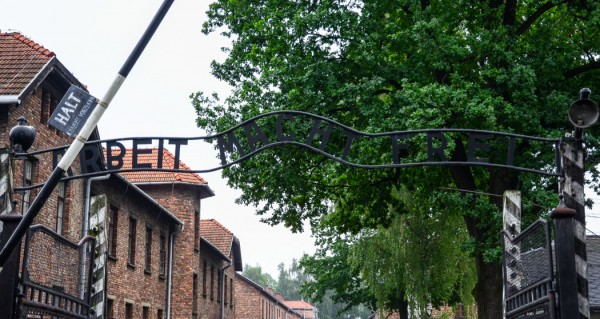
A sign reading “Arbeit Macht Frei” (labor will set you free) marks the entrance to Auschwitz I. A chilling, cruel trick of language – most prisoners of this camp would only find freedom in death.
Auschwitz I opened in 1940 and was housed in 22 existing prewar Polish army barracks. It’s function from 1940 to early 1942 was as a true concentration camp, where political prisoners were to be held by German SS in completely inhuman living conditions that led to slow, deliberate deaths of those interned there.
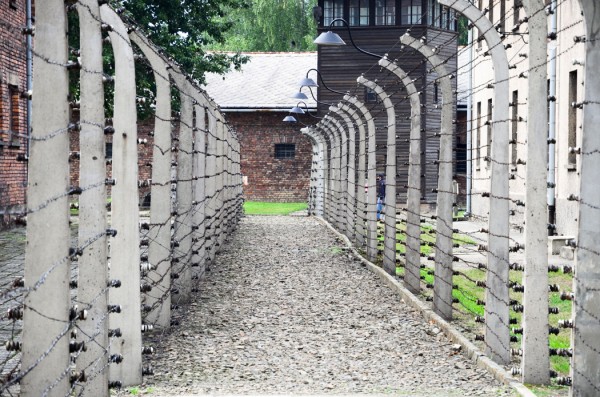
double-fences around Auschwitz I, made of electrified barbed-wire.
Construction on nearby Birkenau camp began in late 1941 to lessen congestion at Auschwitz I, which had reached almost 11,000 prisoners by March of that year. Birkenau was originally designed to hold around 50,000 additional prisoners who were to perform forced labor on site. Accordingly, the entirety of Birkenau camp was built by the slave labor of said prisoners.
Click here for a virtual tour of Auschwitz-Birkenau with photos and information via the Auschwitz Museum website.
As Hitler’s intent to annihilate Europe’s Jewish population became clear, known as the “Final Solution to the Jewish Question” , the purpose of the camps morphed from forced labor prisons to outright mass execution camps with multiple on site gas chambers.
But early in the camp’s history, there was only one gas chamber on site, located in Auschwitz I. The chamber and crematorium (known as Crematorium I) was not a purpose-built extermination chamber – instead, it was converted from an existing onsite bunker, and had capacity for the murder of only a few hundred prisoners at a go.
Brutal medical experiments were carried out on prisoners in Auschwitz I’s Block 10 building, where the infamous “Dr.” Josef Mengele attempted new sterilization techniques via X-ray, attempted to change the color of children’s eyes, experimented wildly with identical twins, and performed vivisections on pregnant women, among other horrors.

Block 10 building.
Next door, Block 11 served as the “prison within a prison”, where interrogations and confinement in cramped standing cells were the norm. Between Block 10 and Block 11 is the Black Wall, where executions by firing squad were routine.
Birkenau became such an important hub for the roundup and murder of European Jews, Poles, Roma and other perceived enemies of the Nazi regime that a railway spur was built directly into the camp in 1944 (prior to this, prisoners were unloaded outside Birkenau’s gate).
Here, at the unloading ramp, “selection” took place as the new prisoners of Birkenau came off the crowded cattle cars they arrived in after long, tortured journeys across Europe and through Birkenau’s main gate, known by prisoners as the “Gate of Death“.
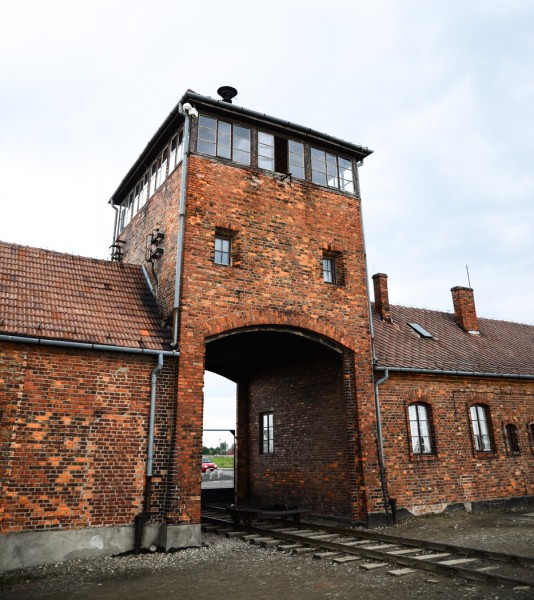
The “Gate of Death” as viewed from the interior of Birkenau.
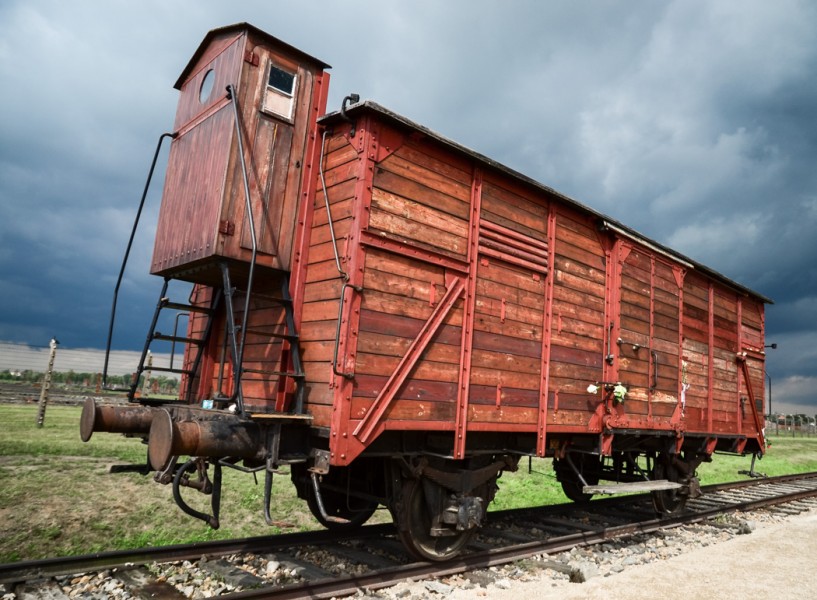
Many of Auschwitz-Birkenau’s victims were transported to the camps via railway cattle car, often with 50-150 people crammed inside. Many died on the way to the camps during journeys that lasted as many as 18 days in duration.
To begin selection, men and women (and thus, families) were segregated and inspected by SS physicians. The weak, sick, elderly and children under the age of 16 were generally sent immediately to the gas chamber, which they were told were showers.
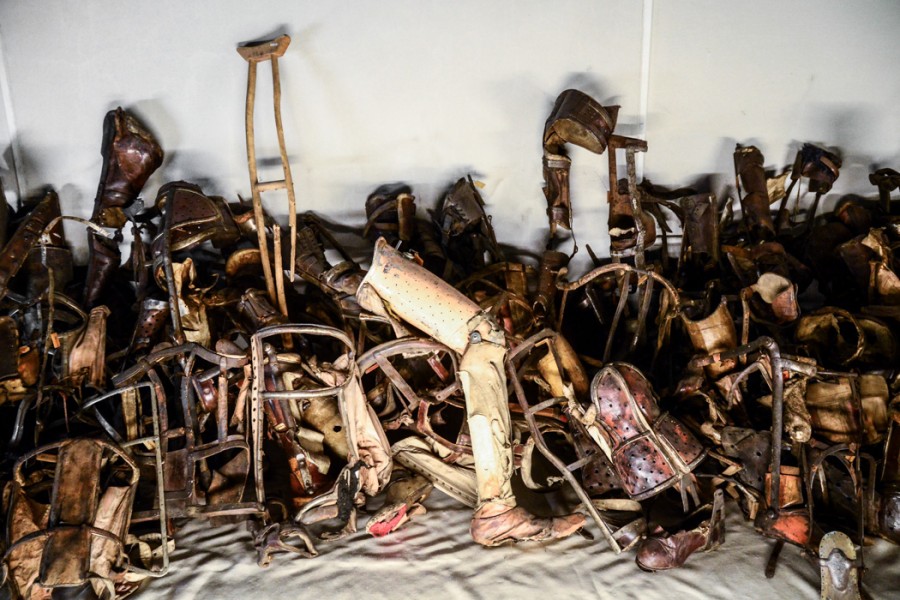
Crutches, prosthetic limbs and other items collected from people that were likely sent directly to the gas chambers after “selection” at Auschwitz-Birkenau.
Once herded inside the changing rooms, rejected men, women and children were forced to disrobe together amongst strangers, an unthinkable moment for a conservative Jew or Pole in 1940s Europe. Then, it was on to the “shower rooms”, where the doors would be locked behind them. Crystals of Zyklon B were dropped through the ceiling, producing cyanide gas and killing everyone in the room within 20 minutes. The screaming is said to have gone on for said duration of time, and could be heard even outside the thick concrete walls of the chambers.
Afterwards, the bodies would be removed from the gas chamber by sonderkommandos, prisoners that were forced to handle the bodies of those murdered (once again, the SS did not participate in the actual work involved, but ruled by very present threats of death). Nine out of ten victims were Jews. Most sonderkommandos were Jews as well.
The hair of the victims would be shaved and collected, their gold fillings and other remaining valuables removed.
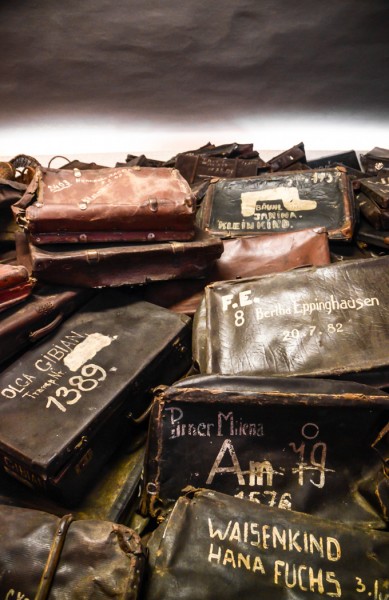
Luggage left behind by victims of Auschwitz-Birkenau.
At selection, those deemed healthy enough for work at selection were interned in the camp.
After hard manual labor, improper housing and clothing, starvation and rampant illness significantly diminished a worker’s vitality, they too were sent to the gas chamber. Photos and documentation of prisoners in the Auschwitz-Birkenau Museum show a regular life span of 2-3 months once a “healthy” prisoner was interned in the camp.
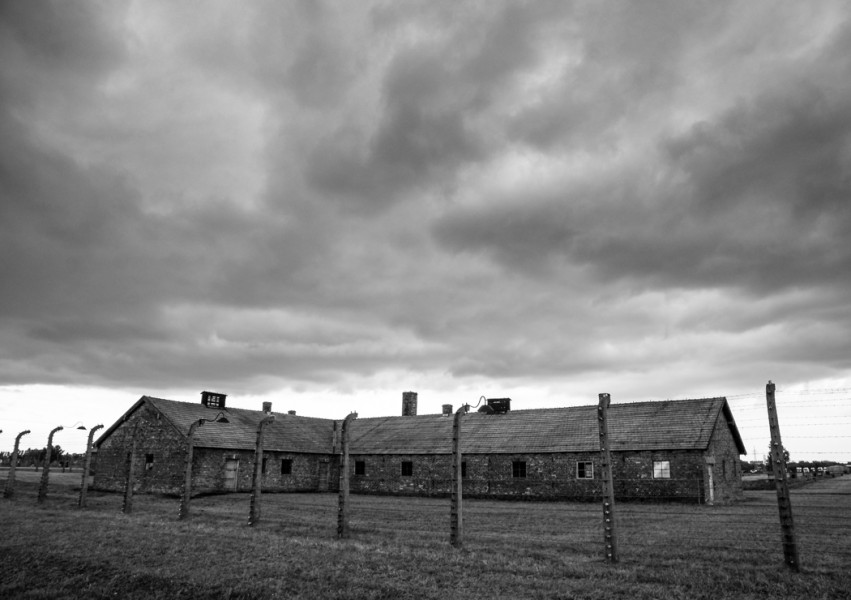
Birkenau camp held six gas chambers over the course of its run – the two provisional gas chambers (with insidious names like “Little Red House” and “Little White House”) gave way to four large permanent combination gas chambers/crematoria (Krema II, III, IV and V) which opened in 1943, boosting the execution and cremation capacity of Birkenau considerably.
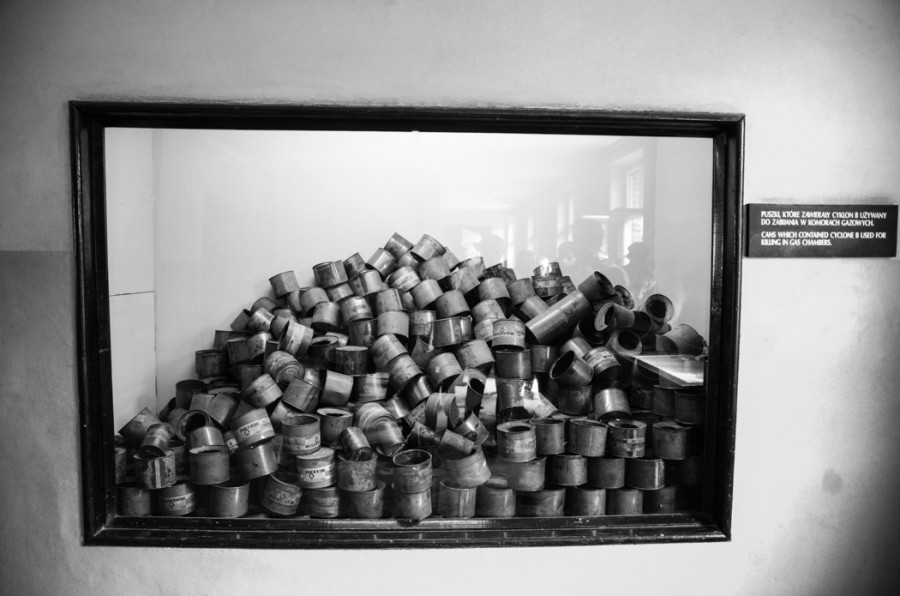
empty canisters of Zyklon B.
The gas chambers in Krema II, III, IV and V could each put about 2,000 persons to death simultaneously, and over 4,000 bodies could be burned in their combined crematoriums daily. Birkenau was now an efficient and capable death machine.
The Nazis would have liked the world to believe that Auschwitz-Birkenau was never a death camp. The SS purposefully demolished Birkenau’s permanent gas chambers and crematoria before the camp was liberated on January 27, 1945 by Soviet troops (the provisional chambers “Red House” and “White House” had been dismantled and destroyed prior).
Only a few thousand prisoners remained in Auschwitz-Birkenau at the time of liberation, many so weak that they could not leave the camp nor be rehabilitated. The Germans had death-marched the majority of the remaining prisoners out of the camp just prior to liberation.
The Soviets discovered artifacts of the killing that had gone on at the camp – hundreds of thousands of men’s suits, 800,000 women’s garments, and more than 14,000 pounds of human hair (reference).

shoes found at Auschwitz-Birkenau.
Auschwitz-Birkenau’s only surviving gas chamber/crematorium is Crematorium I at Auschwitz I, and is a partial reconstruction. Guided tours to Auschwitz-Birkenau visit this space in silence.
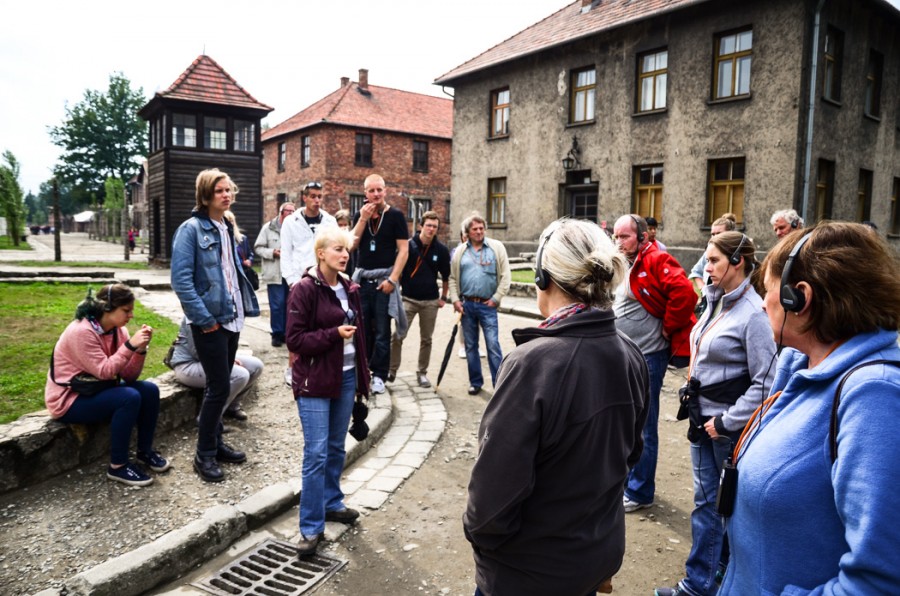
our tour group just outside Crematorium I (not pictured).
Estimates of the total death count at Auschwitz-Birkenau vary. Early postwar estimates reached as high as four million. Revised, more accepted analyses guessed between 1.1 to 1.5 million.
The Auschwitz-Birkenau Museum website breaks out the number of victims of Auschwitz-Birkenau as such:
- Jews – 1.1 million
- Poles – 140-150 thousand
- Gypsies (Roma) – 23 thousand
- Soviet POWs – 15 thousand
- Others – 25 thousand
- Total – Approx 1.3 million
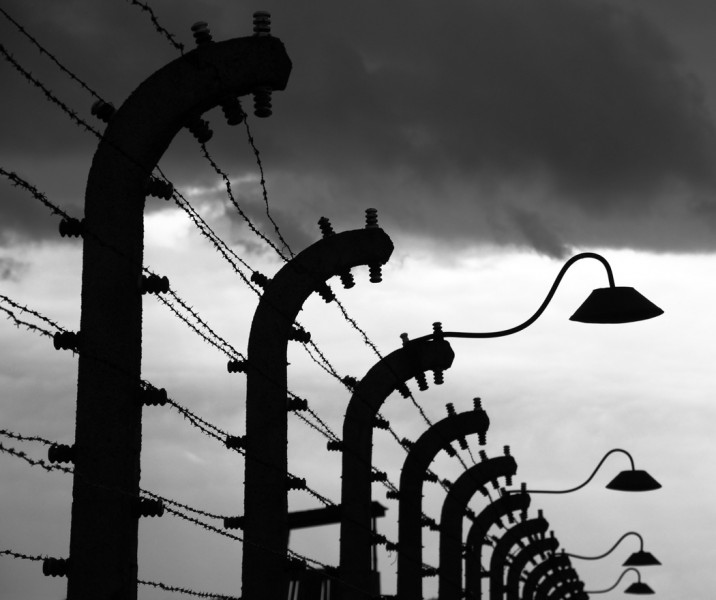
To me, Auschwitz-Birkenau felt like some sort of alien people-eating machine that had to be fed at all costs – I’m still trying to rationalize how it was not this but a massive effort of SENTIENT HUMAN BEINGS that were both capable and willing to commit mass production-style genocide on an unforeseen scale.
The Nazi party used Jews as an “enemy” in their early anti-Semitic propaganda campaigns – a carrier of disease, a lover of money, a subhuman. By proclaiming the inferiority of Jews, they could simultaneously announce the superiority of the party. The Nazis provided their “constituency” with something to hate and to fight against – something other than the regime itself. And this type of technique can be effective in maintenance of tyrannical power.
But the fact that things went so much further – beyond acquisition and solidification of power via demonization of another – and on to wholesale murder of millions of that other – is something I still can’t completely wrap my head around. How could people do this to other people?
Auschwitz I is bleak, ugly, terrifying. Birkenau is massive, sprawling, formidable. And terrifying. Being there brings into immediate focus the hard material reality of the Holocaust. It’s something that sticks with everyone who visits.
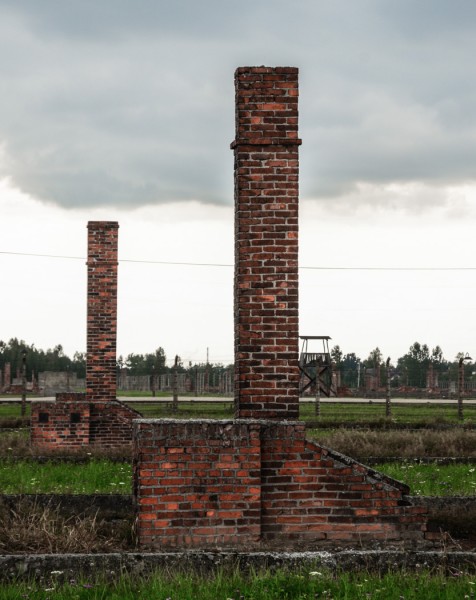
brick chimneys from no-longer-standing buildings at Birkenau.
In the course of my trip in Poland, I met a few other travelers that opted out of a visit Auschwitz-Birkenau, fearing that it would be too much, too heavy of a place for them. Emotions do run high at the camp, but I feel that these people missed a valuable human/historical moment.
Our tour guide brought it to life and embedded the feeling of the camps deep within us. This was among the best guided tours I’ve ever been on (and I generally hate guided tours) – our guide was a master, and her work was as personal and powerful as it was polished.
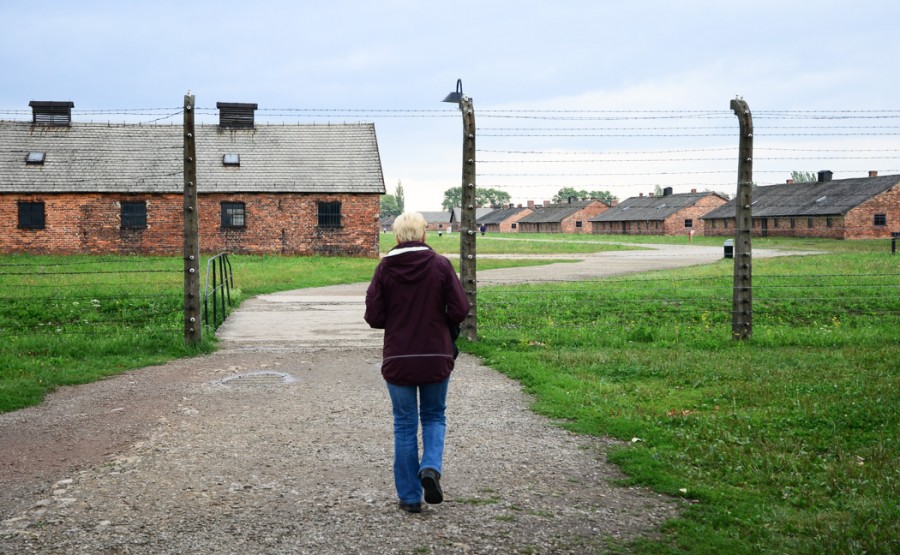
our guide, in Birkenau camp.
If you’re in Kraków make the Auschwitz-Birkenau Memorial and Museum your first priority. And even though it feels like it breaks with the spirit of independent travel a bit, take a guided tour anyway. Budget a full day including transit.
If you’ve got more time in the region, return to Auschwitz-Birkenau to wander independently (or wander after your guided tour if time allows – we were tired and hungry after ours, though). Guided tours don’t cover everything, and an independent visit will give you additional access and more time for meandering, pensive moments and photography.
The information included in this post was sourced from my visit to Auschwitz-Birkenau Memorial and Museum, and from the below sites:
http://en.auschwitz.org/h/
http://www.pbs.org/auschwitz/40-45/index.html
http://www.ushmm.org/wlc/en/article.php?ModuleId=10005189
http://en.wikipedia.org/wiki/Auschwitz_concentration_camp
http://www.scrapbookpages.com/AuschwitzScrapbook/
http://www.jewishvirtuallibrary.org/jsource/Holocaust/auschbirk.html
http://www.deathcamps.org/gas_chambers/gas_chambers_auschwitz.html
http://isurvived.org/AUSCHWITZ_TheCamp.html


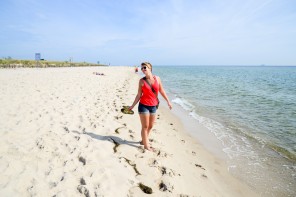
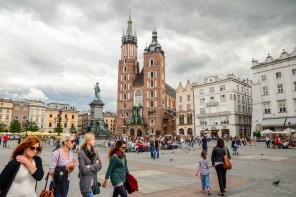

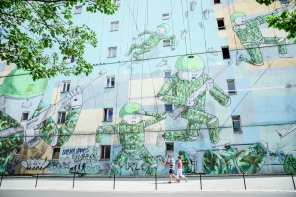
Just to promote a recently set up website on my experience of Auschwitz
http://remembertheholocaust.wordpress.com
Nice post Matt, a good but sad read.
Thank you for this Matt. I love your blog and read everything you post and hold it for reference for future travel. This has always been one of my ‘must see’ places, although I don’t know if I could handle it. Thanks for your insight and thoughts on this terrible place that everyone should witness.
Sent from my iPhone
It’s a total must-see, I agree – and definitely one of the most potent and memorable places I visited in 2012. You can handle it, definitely. There’s so much to learn and feel there.
(Also, I’m flattered. Thanks for reading my stuff!)
My Grandfather was from Krakow….he left years before this, or he might have been one. Your blog was most interesting. ……..someday, maybe I will visit, but for now you have given me more to digest. Thanks Matt
Thanks Breezy!
Thank you for sharing your story. My family’s been meaning to go there for a while, but it’s not exactly everyone’s idea of a fun vacation destination. My great-grandfather died in a Nazi-run POW camp in the north of Poland, the ruins of which my mom visited on a very emotional trip, but again, it wasn’t something I was quite ready to commit to myself.
As for your questions regarding how sentient human beings can do this to one another, the absolute best work on the matter, in my view, is Hannah Arendt’s “Eichmann in Jerusalem”. It’s a terrifying read, but it breaks down how an ordinary man, simply following orders, neatly organized the rounding up, deportation, and murder of several million people in a completely calm manner, as if he were sorting office files or doing his taxes.